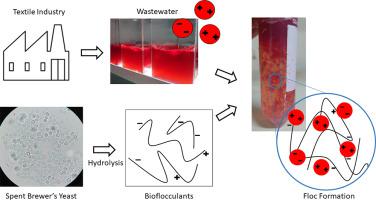Journal of Water Process Engineering ( IF 6.3 ) Pub Date : 2022-07-13 , DOI: 10.1016/j.jwpe.2022.102997 Wagner Artifon , Luciana Prazeres Mazur , Antônio Augusto Ulson de Souza , Débora de Oliveira

|
Advances in chemical synthesis have increased the complexity and degradation resistance of dyes used in textile processes. This fact interferes drastically with conventional biological wastewater treatment and demands further methods to avoid environmental damage. In this sense, this work presents a bioflocculant produced by the alkaline hydrolysis of spent brewer's yeast, a residue from the brewing industry, as well as the evaluation of its performance in the precipitation of recalcitrant dyes. The optimum hydrolysis system was accessed by a full 23 factorial design in terms of NaOH concentration, yeast mass, and temperature, followed by a kinetic study. The solid fraction composition of the produced flocculant agent is 46 % of proteins and 29 % of polysaccharides. The performance of the bioflocculant was evaluated in two different systems, real textile wastewater containing rhodamine and a synthetic solution with flavine. The effects of the flocculation variables pH, temperature, agitation, and flocculant agent dosage were taken into consideration. Color removal outcomes above 80 and 90 % were attained for rhodamine and flavine systems, respectively. Further analysis of real textile wastewater for treated and untreated samples in terms of BOD, COD, TOC, and light metals was performed. A biodegradability test showed the employed treatment could increase microbial assimilation of the sample and reduce its persistent compounds. This work shows, for the first time, the feasibility of the bioflocculant from spent brewer's yeast and features its potential applicability to recalcitrant compounds precipitation in textile wastewaters.
中文翻译:

用废啤酒酵母生产生物絮凝剂及其在纺织染料废水处理中的应用
化学合成的进步增加了纺织工艺中使用的染料的复杂性和抗降解性。这一事实严重干扰了传统的生物废水处理,需要进一步的方法来避免环境破坏。从这个意义上说,这项工作介绍了一种由废啤酒酵母碱水解产生的生物絮凝剂,这是酿造工业的残留物,以及对其在顽固性染料沉淀中的性能的评估。最佳水解系统由完整的 2 3根据 NaOH 浓度、酵母质量和温度进行因子设计,然后进行动力学研究。所生产的絮凝剂的固体组分组成为46%的蛋白质和29%的多糖。生物絮凝剂的性能在两种不同的系统中进行了评估,即含有罗丹明的真实纺织废水和含有黄素的合成溶液。考虑了絮凝变量 pH、温度、搅拌和絮凝剂用量的影响。罗丹明和黄素系统的脱色效果分别达到 80% 和 90% 以上。在 BOD、COD、TOC 和轻金属方面对处理和未处理样品的实际纺织废水进行了进一步分析。生物降解性测试表明,所采用的处理可以增加样品的微生物同化并减少其持久性化合物。这项工作首次展示了来自废啤酒酵母的生物絮凝剂的可行性,并具有其在纺织废水中难降解化合物沉淀的潜在适用性。











































 京公网安备 11010802027423号
京公网安备 11010802027423号